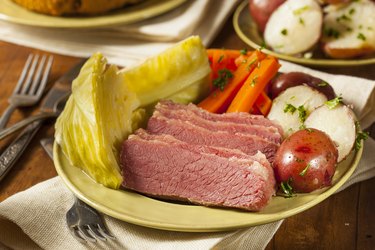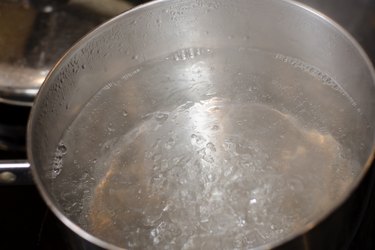There are a lot of fully cooked hams in stores, but it’s tradition to glaze and cook the ham first, which makes it taste even better. Cooking ham in a convection oven means adjusting both temperature and cook time slightly from conventional oven recipes.
There are so many kinds of ham that the USDA Food Safety and Inspection Service (USDA FSIS) wrote an entire article to explain the differences and how to cook each kind. So before you start cooking, make sure you know what kind of ham youre dealing with.
One of the most important questions you may have is: What’s the difference between cured and uncured ham? Curing meat means adding salt, nitrites or nitrates, and other spices to help it stay fresh and develop its color and flavor. Curing spices can be rubbed on the meat or injected into it. Depending on the method used, they can give the meat a rich flavor and a color that ranges from deep pink to mahogany.
Your ham may also be smoked, boiled or, less commonly, completely uncured. This ham is called “fresh” and will be marked as such. It will be pale beige or pink, like a pork roast that hasn’t been cooked yet.
Because different kinds of ham are so different, even the USDA FSIS says to read the label carefully to make sure you know what kind of ham you have and how to cook it right.
A beautiful golden glazed spiral ham is the centerpiece of many holiday meals. While most hams sold at the grocery store are fully cooked, they still benefit greatly from some additional oven time to heat through and caramelize the signature glaze. Cooking spiral ham in a convection oven allows you to achieve moist, tender meat encased in a crispy, flavorful exterior in record time.
Convection ovens have a fan that circulates hot air around the food. This enables fast, even cooking, especially for large roasts and hams. With a few simple convection oven adjustments, you can cook spiral ham to juicy perfection. In this complete guide, I’ll cover tips for selecting, prepping, glazing, and convection roasting spiral ham with foolproof results.
Benefits of Cooking Spiral Ham in a Convection Oven
There are a few advantages to using the convection setting on your oven when cooking spiral ham
-
Quicker cooking time – The circulating hot air speeds up cooking 20-30% faster than a conventional oven.
-
Caramelized exterior – The constant movement of hot air helps form a sticky candied glaze on the ham.
-
Moist interior – The reduced cooking time limits moisture loss.
-
Self-basting – The fan movement bastes the ham in its own juices for added flavor.
-
Even heating – No hot or cold spots mean the ham cooks evenly from edge to center.
For the fastest, most flavorful glazed spiral ham possible, convection ovens can’t be beat!
Selecting a Quality Bone-In Spiral Cut Ham
When choosing a spiral cut ham, look for the following:
-
Bone-in – The bone helps retain moisture and impart flavor. Avoid boneless.
-
Uncut surface – Avoid hams with large cross-section slices exposing the interior.
-
Pink/red color – Paler hams may be older. Dark spots indicate drying.
-
Flexible meat – Meat shouldn’t be overly firm. Some bend indicates tenderness.
-
Thin fat cap – Thick slabs of white fat prevent caramelization.
-
Mild cured aroma – Strong odors suggest a very aged or old ham.
For the best results, purchase bone-in, unsliced spiral ham from a trusted butcher or specialty market if you can. The quality is noticeably better than factory packaged grocery varieties.
Prepare the Ham
Before cooking, you’ll need to get the ham ready for the oven:
-
Unpack – Remove all packaging, paper, and netting. Rinse if desired.
-
Trim – Use a sharp knife to trim off hardened fat or skin. Leave about 1⁄4 inch fat.
-
Score – Make shallow diagonal cuts across the ham’s surface. This helps the glaze adhere.
-
Stud – Stick whole cloves into the ham for extra flavor. Arrange in lines between cuts.
-
Stand – Place ham cut-side down on a rack in a shallow roasting pan. Add 1 cup broth or water to the bottom to prevent burning.
Your seasoned, scored, and studded ham is now ready for some sweet glazy goodness!
Mix Up a Flavorful Glaze
A good ham glaze balances sweet, spicy, and tangy flavors. Brush on a few coats during roasting for a crave-worthy candied crust. Here are some yummy glaze ideas:
- Brown sugar + mustard + pineapple juice + cloves
- Honey + brown sugar + ginger + cinnamon
- Orange marmalade + bourbon + cracked pepper
- Pure maple syrup + chipotle chili flakes + lime juice
- Brown sugar + hoisin sauce + rice vinegar + crushed garlic
Simmer your glaze of choice for 5-10 minutes until thickened before basting onto the ham.
Adjust Oven Temperature for Convection Cooking
Convection ovens circulate hot air for faster cooking than conventional ovens. To convert standard recipes, reduce the temperature by 25°F.
So if a ham recipe calls for 325°F oven, set your convection oven to 300°F instead.
Always preheat your convection oven fully before placing the ham inside. Position the ham centrally for the most even air flow.
Determine Doneness
The best way to know when spiral ham is cooked through is to use an instant-read meat thermometer. Check temperature in the thickest, meatiest section avoiding the bone.
For fully cooked hams, heat to an internal temperature of 130-140°F.
For fresh, uncured hams, cook to at least 145°F.
Let the ham rest 15 minutes before carving for the juices to redistribute.
Step-by-Step Instructions
Follow these simple steps for perfectly cooked glazed spiral ham:
-
Prepare ham by trimming, scoring, and studding with cloves. Place cut-side down on a rack in a pan with 1 cup liquid.
-
Mix your favorite glaze ingredients and simmer until thickened. Reserve half for serving.
-
Preheat convection oven to 300°F. Reduce standard temperature by 25 degrees.
-
Brush ham all over with half of the glaze. Roast 25-30 minutes per pound until 130-145°F internally.
-
Glaze ham again halfway through cooking. Add reserved glaze once more during last 30 minutes.
-
For caramelized crust, switch oven to broil for 1-2 minutes watching closely to avoid burning.
-
Let ham rest 15 minutes before slicing. Serve with extra glaze.
The constant circulation of hot air helps the glaze turn sticky, rich, and caramelized. Your spiral ham will have a beautifully lacquered exterior encasing tender, juicy meat inside.
FAQs About Convection Oven Spiral Ham
Get answers to some common questions about convection roasting spiral ham:
How long does it take to cook a 10 lb spiral ham in a convection oven?
- At 300°F, allow about 4-5 hours total cooking time.
Should you cover ham when cooking it in the oven?
- For moist ham, tent foil over it until the last 30 minutes, then remove to glaze and brown the exterior.
What is the best way to reheat leftover spiral ham?
- Slice ham and pack into a baking dish. Add a bit of water or glaze and cover with foil. Bake at 325°F until warmed through, about 20-30 minutes.
Can you freeze and reheat spiral ham?
- Yes! Freeze sliced ham up to 2 months. Reheat frozen ham wrapped in foil at 300°F until 140°F internally, about 1 hour. Add glaze once ham is hot.
What happens if you overcook spiral ham?
- It may taste dry, salty, and stringy. Try slicing thin and serve with sauce or gravy to add moisture.
With these convection oven tips, you can relax knowing your holiday spiral ham will turn out perfect. The hot circulating air gives the ham a candied, caramelized exterior while keeping the inside tender and juicy.

Prep Your Ham and Glaze
In most cases, youll be dealing with a fully cooked ham. Prepare it by trimming away excess fat and scoring it all over with a sharp knife. Make these shallow cuts in opposing directions to create a square or diamond pattern for better coverage.



Place the ham on a rack in a broiling pan. If the ham is whole, put it on its side; if it’s cut, put it cut-side down. Wet the bottom of the pan with water to help the ham stay moist. Adding herbs to the water will also make the ham taste better. If you dont have a cover for the broiling pan, create a foil tent over the ham.
Next, combine sweet and tangy ingredients to create a glaze. Adding brown sugar, Dijon mustard, and apple cider vinegar to taste and stirring them together will make a simple but tasty glaze. Simmer the glaze until it’s about half gone. Other common glaze ingredients include honey, rice vinegar, pepper, Worcestershire sauce and assorted spices.
As youre prepping the ham, set the oven to preheat. Most of the cooking temperatures published for ham are calculated for a conventional oven. Most experts say that if you use a convection oven instead of a regular oven, you should set it 25 degrees Fahrenheit lower.
If your ham doesnt have specific temperature directions on it, the USDA FSIS recommends setting a conventional oven no lower than 325 F to reheat a pre-cooked ham — which translates to 300 F for a convection oven.
Once the oven is preheated, slide the pan into its center. Different experts have different ideas about how often you should glaze your ham. Some say to do it every 10 to 20 minutes and baste it with pan juices while you’re at it, while others say that just one glaze, about 20 minutes before the ham is done, is enough.
To get a delicious, caramelized crust on your glazed ham, glaze it many times. Then, near the end of the cooking time, take off the foil tent or lid and set the oven to broil for a few minutes. Watch carefully to make sure the ham doesnt burn.
The University of Kentucky says that convection ovens cook food up to 25 percent faster than regular ovens. But converting convection oven vs. regular cooking times isnt an exact science. If you use a meat thermometer to check when your ham is done, you can be sure of good results and safe food.
According to FoodSafety.gov, a cooked ham (which is what youll most commonly find in stores) should be reheated to an internal temperature of 165 F — although they allow an exception of 140 F for cooked hams that were packaged in a USDA-inspected plant. If youre working with a fresh ham, it should be heated to an internal temperature of 145 F, then allowed to rest for three minutes.
If you have an oven-safe leave-in thermometer, you can check the temperature inside the ham without even opening the oven door.
The USDA FSIS recommends placing your meat thermometer midway into the cut of meat; if the bone is still in your ham, place the thermometer to avoid it. And if your ham is an irregular shape, check its temperature in several places to be sure its cooked all the way through.
